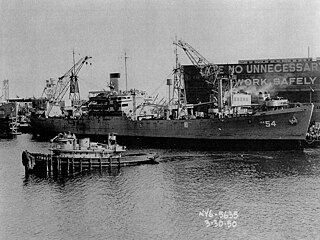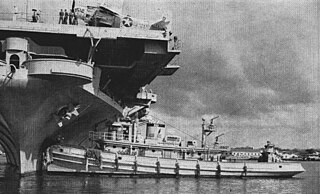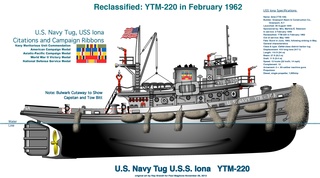USS Watseka (YTM-387) was a medium harbor tug of the YTM-192 class in the service of the United States Navy during World War II. The Naval Historical Center lists the namesake as: "Possibly a variant spelling of Watsaghika, a former village of the Iruwaitsu Shasta Indian tribe of northern California, at the extreme west end of Scott Valley."
USS Pocahontas (YT-266/YTB-266/YTM-266) was a type V2-ME-A1 Hiawatha-class yard tug in the United States Navy during World War II.
USS Osceola has been the name of more than one United States Navy ship, and may refer to:

USS Quileute (YTB–540), later YTM-540, was a United States Navy harbor tug in service from 1945 to ca. 1974.

USS Nokomis (YT-142/YTB-142/YTM-142) was a Woban-class harbor tug built in Bremerton, Wash, and assigned to Pearl Harbor, Hawaii, in 1940. Nokomis was present during the Japanese attack on Pearl Harbor, 7 December 1941. She was the first vessel on scene at the USS Arizona, and was called off by the officers on deck because of the imminent explosion of the battery below deck. It then left and helped beach the USS Nevada, with Hoga (YT-146), and YT-153. The beaching of the Nevada saved Pearl Harbor's mouth from being blocked. After that the USS Nokomis fought fires and dewatered the battleship USS California, for 3 days. This effort made the California salvageable, to be recommissioned again later in the war. Nokomis was also the last vessel to move the surviving YC-699 barge prior to the Japanese attack on Pearl Harbor. Post-war she continued serving Pearl Harbor ships until she was decommissioned in May 1973, and eventually sold for "scrap" to Crowley, in San Francisco. She was renamed Sea Serpent and served many years in the San Francisco Bay as a tug and fire boat. In 1989, after the Loma Prieta earthquake in the SF Bay area, Nokomis and Hoga fought fires alongside each other again.

USS Wenonah (YT-148/YTB-148/YTM-148) was a Woban-class district harbor tug which served during World War II in California ports, and continued her service until she was struck by the Navy in 1974. On 17 August 2009, the Wenonah sank while berthed at Treasure Island, CA, and was raised by the floating crane Left Coast Lifter on 28 August 2009.

USS Kittaton was a Sassaba-class district harbor tug that served the U.S. Navy at the end of World War II. She served in the Pacific Ocean, often in the Japan and Philippine Islands area and was eventually struck from the Navy list at an unspecified date.
USS Tensaw (YT-418/YTB-418/YTM-418) was a Sassaba-class district harbor tug that served the United States Navy at the end of World War II. She remained in the Pacific Ocean to support the U.S. Pacific Fleet during the Korean War, and continued to serve until she was struck in 1967.
USS Waneta (YT-384), later YTB-384, later YTM-384, was a United States Navy harbor tug in commission from 1944 to 1946 and from 1953 to 1974.
USS Wannalancet (YTB-385), projected as YT-385, later YTM-385, was a United States Navy harbor tug in commission from 1944 to 1946.
USS Washakie (YTB-386), laid down as YT-386, later YTM-386, was a United States Navy tug in commission from 1944 to 1946 and from 1953 to probably 1975.
USS Waubansee (YTB-366), originally YT-366, later YTM-366, was a United States Navy harbor tug commissioned in 1944 and stricken in 1983.

The third USS Hiawatha (YT-265), later YTB-265, later YTM-265, was a type V2-ME-A1 harbor tug that entered service in the United States Navy in 1942 and was sold in 1987.

USS Alamingo (YT-227) was laid down on 13 April 1944 at Camden, New Jersey, by the Mathis Yacht Building Co.; reclassified a large harbor tug and redesignated YTB-227 on 15 May 1944; launched on 21 October 1944; and placed in service on 19 February 1945.

USS Menoquet (YTM-256) was laid down as YT‑256 by Anderson and Cristofani, San Francisco, California 11 September 1943; named Menoquet 5 January 1944; launched 5 February 1944, sponsored by Mrs. Alfred Cristofani; reclassified YTB‑256 on 15 May 1944; and completed and placed in service at Mare Island, California., 7 June 1944. Harbor tugs (YT) were named after American Indian tribes.

USS Oneyana (YTB-262) was a U.S. Navy tugboat laid down as YT–262, 20 June 1943 at J.M. Martinac Shipbuilding Corp., Tacoma, Washington launched 27 March 1944; reclassified YTB 262, 15 May 1944: and placed in service 23 August 1944.

USS Neoga (YTB-263) was laid down as YT–263, 24 December 1943, by the J.M. Martinac Shipbuilding Corp., Tacoma, Washington; named Neoga 28 April 1944; reclassified YTB–263, 15 May 1944; launched 13 June 1944; and placed in service 21 October 1944.

Iona (YT/YTB/YTM-220), a wooden tugboat originally classified YT-220, was launched by Greenport Basin and Construction Company, Greenport, New York, 26 August 1944; sponsored by Mrs. Martina E. Swanson; and placed in service 2 February 1945. She was the second United States Navy ship of that name.
USS Wingina (YTB-395) is a tugboat that was laid down as District Harbor Tug YT-395. She was re-classified while still under construction as District Harbor Tug, Large YTB-395. After her commissioning, she served in the United States Navy from 1944 to 1980.

The Type V ship is a United States Maritime Commission (MARCOM) designation for World War II tugboats. Type V was used in World War II, Korean War and the Vietnam War. Type V ships were used to move ships and barges. Type V tugboats were made of either steel or wood hulls. There were four types of tugboats ordered for World War II. The largest type V design was the sea worthy 186-foot (57 m) long steel hull, V4-M-A1. The V4-M-A1 design was used by a number of manufacturers; a total of 49 were built. A smaller steel hull tugboat was the 94-foot (29 m) V2-ME-A1; 26 were built. The largest wooden hull was the 148-foot (45 m) V3-S-AH2, of which 14 were built. The smaller wooden hull was the 58-foot (18 m) V2-M-AL1, which 35 were built. Most V2-M-AL1 tugboats were sent to England for the war efforts under the lend-lease act. The Type V tugs served across the globe during World War II including: Pacific War, European theatre and in the United States. SS Farallon and other Type V tugs were used to help built Normandy ports, including Mulberry harbour, on D-Day, June 6, 1944 and made nine round trips to Normandy to deliver Phoenix breakwaters.










